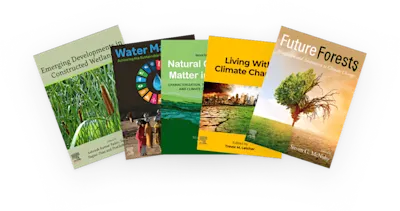
Economic Approaches to Environmental Problems
Techniques and Results of Empirical Analysis
- 1st Edition - February 17, 2016
- Latest edition
- Authors: D. E. James, H.M.A. Jansen, J.B. Opschoor
- Editor: R.J. Wakeman
- Language: English
Fundamental Aspects of Pollution Control and Environmental Science, 3: Economic Approaches to Environmental Problems: Techniques and Results of Empirical Analysis focuses on the… Read more

Fundamental Aspects of Pollution Control and Environmental Science, 3: Economic Approaches to Environmental Problems: Techniques and Results of Empirical Analysis focuses on the application of economic approaches in the management and control of environmental problems. The book first offers information on the relationship of economics and the environment and environmental pollution and external effects. Discussions focus on concepts of the environment, environmental services, need for assessment methods, health effects of air pollution, and annoyance and other health effects due to aircraft noise. The text also examines the homogeneous pollution approach and monetary damage functions. The publication takes a look at project evaluation and environmental deterioration and general-equilibrium assessment models. Topics include linear programming models, aggregation of flows of costs and benefits through time, projects, effects, and aggregation, and illustrations of cost benefit. The selection is a dependable reference for readers interested in the economic approaches to environmental problems.
PrefaceChapter 1. Economics and the Environment The Scope of Economic Analysis Neoclassical Welfare Theory Concepts of the Environment Environmental Services Environmental Decisionmaking The Need for Assessment Methods Some Alternative Views References Chapter 1Chapter 2. Environmental Pollution and External Effects Introduction External Effects Defined Relevant External Effects Pollution as External Effect Physical Damage Functions Some Health Effects of Air Pollution Annoyance and Other Health Effects Due to Aircraft Noise Some Conclusions Literature ChapterChapter 3. Costs and Benefits of Pollution Control — The Homogeneous Pollution Approach Introduction a Model of Optimal Pollution Ecologic and Economic Optima Environmental Quality Evaluation Problems Final Remarks Literature ChapterChapter 4. Monetary Damage Functions Introduction Neoclassical Value Judgments Individual Monetary Damage Functions Problems of Individual Welfare Societal Damage Functions Methods of Measuring Monetary Damage Conclusions and Final Remarks Appendix 4A. Pollution and House Prices Appendix 4B. Welfare Effects of Noise Appendix 4C. Estimates of Pollution Damage on Nationwide Scale Literature Chapter 4 Chapter 5. Project Evaluation and Environmental Deterioration Projects, Effects, Aggregation Cost-Benefit Analysis As Applied Welfare Economics The Basis For Evaluation Distributional Problems Aggregation of Flows of Costs and Benefits Through Time Some Illustrations of Cost Benefit Analysis Other Types of Single-Criteria Analysis Multi-Criteria Analysis Some Conclusions Literature Chapter 5 Chapter 6. General-Equilibrium Assessment Models Introduction Basic Features of Input-Output Models The Input-Output Approach Flow Matrices The Direct Requirements Matrix The Total Requirements Matrix Factor Incomes Employment Price Equations Horizontal Coefficients Dynamic Models Linear Programming Models Optimization Problems Simple Example The General Programming Problem Duality Integer Programming Nonlinear Programming References Chapter 6 Chapter 7. Materials Balance and the Prediction of Residuals Flow Introduction Materials Balance Models The Ayres-Kneese Model Victor's Model Operational Models of Materials Flows Empirical Models Environmental Inputs Residual Discharges, Direct Coefficients Cumulated Coefficients Environmental Damage and Materials Flows Diffusion Models Appendix 7A. Residuals by Source and Type Appendix 7B. Input-Output Forecasts of Pollution Levels Appendix 7C. Indirect Pollution Effects: A Comparison of Three Air Pollution Studies References Chapter 7 Chapter 8. Input-Output Modeling of Pollution Abatement Policies Introduction Structural Abatement Technical Abatement The Direct Financial Expenditure Approach Input Substitution The Dummy Industry Approach Other Methods of Technical Abatement Effects of Pollution Abatement on International Trade Empirical Results Costs of Pollution Abatement Price Effects Output and Employment Effects Appendix 8A. Structural Abatement: A Dutch Case Study References Chapter 8 Chapter 9. Mathematical Programming Models of Air Pollution Control Introduction Control of a Single Pollutant Technical Abatement Models Structural Abatement Models Combination of Structural and Technical Abatement General Remarks Appendix 9A. Air-Pollution Abatement Technologies: Characteristics and Cost-effectiveness References Chapter 9 Chapter 10. Modeling the Interaction of Economic and Ecological Systems Introduction Characteristics of Natural Ecosystems Food Chains Bioenergetics Biogeochemical Cycles Ecological Succession Ecological Impacts of Economic Activity Economic-Ecologic Models Objectives of Economic-Ecologic Modeling Daly's Model Isard's Model Energy Flow Matrices Further Input-Output Ecological Models Constraints on Ecosystem Performance A Synthesis Economic-Ecologic Model Final Reflections Oo10Chapter 11. Instruments of Environmental Policy Introduction Taxing Pollution Other Economic Instruments Pollution Rights Subsidies Compensation Direct Regulations Economic Side-Effects of Environmental Policy Simultaneous Application Measures References Chapter 11
- Edition: 1
- Latest edition
- Published: February 17, 2016
- Language: English